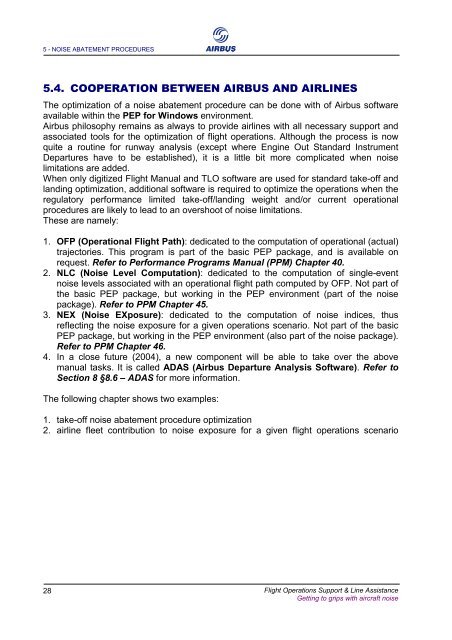Getting to Grips with Aircraft Noise
Getting to Grips with Aircraft Noise
Getting to Grips with Aircraft Noise
Create successful ePaper yourself
Turn your PDF publications into a flip-book with our unique Google optimized e-Paper software.
5 - NOISE ABATEMENT PROCEDURES<br />
5.4. COOPERATION BETWEEN AIRBUS AND AIRLINES<br />
The optimization of a noise abatement procedure can be done <strong>with</strong> of Airbus software<br />
available <strong>with</strong>in the PEP for Windows environment.<br />
Airbus philosophy remains as always <strong>to</strong> provide airlines <strong>with</strong> all necessary support and<br />
associated <strong>to</strong>ols for the optimization of flight operations. Although the process is now<br />
quite a routine for runway analysis (except where Engine Out Standard Instrument<br />
Departures have <strong>to</strong> be established), it is a little bit more complicated when noise<br />
limitations are added.<br />
When only digitized Flight Manual and TLO software are used for standard take-off and<br />
landing optimization, additional software is required <strong>to</strong> optimize the operations when the<br />
regula<strong>to</strong>ry performance limited take-off/landing weight and/or current operational<br />
procedures are likely <strong>to</strong> lead <strong>to</strong> an overshoot of noise limitations.<br />
These are namely:<br />
1. OFP (Operational Flight Path): dedicated <strong>to</strong> the computation of operational (actual)<br />
trajec<strong>to</strong>ries. This program is part of the basic PEP package, and is available on<br />
request. Refer <strong>to</strong> Performance Programs Manual (PPM) Chapter 40.<br />
2. NLC (<strong>Noise</strong> Level Computation): dedicated <strong>to</strong> the computation of single-event<br />
noise levels associated <strong>with</strong> an operational flight path computed by OFP. Not part of<br />
the basic PEP package, but working in the PEP environment (part of the noise<br />
package). Refer <strong>to</strong> PPM Chapter 45.<br />
3. NEX (<strong>Noise</strong> EXposure): dedicated <strong>to</strong> the computation of noise indices, thus<br />
reflecting the noise exposure for a given operations scenario. Not part of the basic<br />
PEP package, but working in the PEP environment (also part of the noise package).<br />
Refer <strong>to</strong> PPM Chapter 46.<br />
4. In a close future (2004), a new component will be able <strong>to</strong> take over the above<br />
manual tasks. It is called ADAS (Airbus Departure Analysis Software). Refer <strong>to</strong><br />
Section 8 §8.6 – ADAS for more information.<br />
The following chapter shows two examples:<br />
1. take-off noise abatement procedure optimization<br />
2. airline fleet contribution <strong>to</strong> noise exposure for a given flight operations scenario<br />
28<br />
Flight Operations Support & Line Assistance<br />
<strong>Getting</strong> <strong>to</strong> grips <strong>with</strong> aircraft noise


